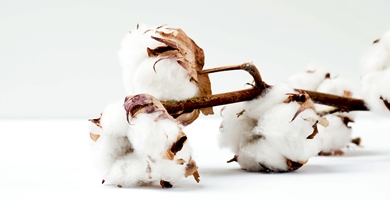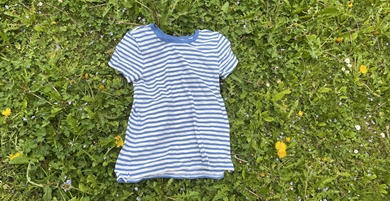Clothes recycling
"Consumers should ask critical questions"
Switzerland and the EU are pushing the reuse of raw materials. But despite the best efforts, the circular economy in the textile industry sometimes produces abstruse blossoms. After all, recycling can also harm the environment. Empa researcher Claudia Som dispels sustainability myths in an interview and tells consumers how to recognize black sheep.

Ms. Som, together with your colleagues at Empa, you investigated the environmental impact of an outdoor jacket made of recycled material. One of the results was that the use of polyester from PET bottles does not yield any advantage – perhaps surprisingly for laypeople. Did you expect that?
Even before our study, we had heard from experts in the packaging industry that "bottle PET" would be better left in the bottle cycle for quality reasons. There were even rumors that resourceful entrepreneurs abroad were producing PET bottles not for beverages, but to profit from the high demand for "recycled PET." Therefore, it is necessary to look closely at where the PET comes from and what quality requirement it must meet for a number of recycling loops – especially if many of those are to be achieved.
Recycling and circular economy in the textile sector has long been an issue in politics as well. You recently conducted a survey among Swiss textile companies to explore the potential. What were your findings?
The idea to take a closer look at production waste in the textile industry came to us during a company visit. Although the company tried to reduce waste and find a sensible reuse, a large part of high-value materials ended up being incinerated. Often, companies also remain in the dark about what buyers do with the material. What was interesting for us was that designers can also help to avoid production waste – for example, by tolerating color deviations.
Today, most clothing ends up in incineration or landfills at the end of its life. How high do you estimate the potential for recycling?
From our contacts with Swiss and European industry, we have learned that successful recycling depends on how well you know the composition and quality of your materials. Moreover, large enough quantities are required for the processes to become economical. Today's clothes that are sometimes made of really wild material mixtures and our "fast fashion" approach with low material quality make successful recycling quite tricky. Thus, we hope that our research on Swiss production waste will contribute to establishing a circular economy faster. After all, in Swiss as well as in European production, the quality of the materials is relatively high, the composition is largely known, and relatively large quantities of the same material are produced.
| Audio |

Radio program on SRF4 of March 24, 2022, in German
|
Further information Claudia Som Editor / Media contact Norbert Raabe Literature |
|
Subitex – together for sustainable textiles
The Subitex research initiative of Empa and the Swiss Textiles industry association aims to enable sustainable management in the textile industry. Through innovative approaches and efficient knowledge and technology transfer, innovations should reach the market faster. Among other things, the researchers are analyzing the environmental impact, developing fibers from bio-based plastics and novel technologies for alternative materials. The initiative was launched in 2014 and, with a recent refocus on textile sustainability, has developed into a wide-ranging innovation network with currently 15 companies. More information on: https://subitex.empa.ch/
Recycling trap 1: Evil petroleum

In the case of textiles, common wisdom has it that it is rather easy to distinguish between those that are friendly to the environment and those that are harmful. Based on rough estimates, polyester was considered the manifestation of evil, while cotton as a natural fiber was seen as the good guy. Empa researcher Mélanie Schmutz has now investigated the environmental impact of fiber production. Her calculations show that in terms of CO2 emissions, both fiber types are on a par. The water consumption is different, though: The fiber production for a cotton T-shirt leaves a water footprint of 50 cubic meters, which corresponds to a 20 m2 room filled to the ceiling with water. For polyester, on the other hand, it's less than one cubic meter. In terms of fossil fuel consumption, however, fiber production for a T-shirt made of polyester comes off worse; at just under 25 MJ equivalents, it requires as much as 2,000 AA batteries (cotton: 750 AA batteries). Conclusion: "None of the fabrics is really good or bad. It depends on the requirements of the fiber and the specific manufacturing process," says Schmutz.

Recycling trap 2: Good natural fibers
Until now, synthetic textiles have been made, for the largest part, from petroleum. The use of renewable raw materials such as cellulose could improve the environmental compatibility of our clothing. Empa researchers Tijana Ivanović and Claudia Som have now compared the environmental impact of conventional polyester with that of bio-based variants. They concluded that only three of the nine substitute products achieve a similar environmental impact as polyester. The remaining "bio-polymers" performed worse. The reason: The raw materials are currently produced using intensive agriculture, and the conversion rate from raw material to textile fiber is not efficient – for example, four kilograms of corn are needed for one kilogram of fiber. The next step for the researchers will therefore be to look at alternative processes that use deciduous leaves, for instance.
Does recycling make sense in every case?
Recycling is not always sustainable. On the one hand, the effort required for recycling can be high – if only because of the logistics. On the other hand, problems can arise from material and quality losses or from impurities in every recycling process. The EU and Switzerland want to strongly push recycling. However, this could lead to even greater environmental problems – for example, if the recycling technology requires a lot of resources.
There are now numerous initiatives from manufacturers, such as labels for sustainable products or recycling – this can be quite confusing for customers. Do you have any tips for consumers to find their way around?
Even experts have trouble keeping track of the topic. I recommend the label guides from non-governmental organizations. Consumers should also ask critical questions, such as where the PET comes from, where it is produced. That way, you at least get an idea of how much the suppliers know and how committed they are.
In the Subitex research initiative (see info box) Empa researchers are working together with the textile industry in an interdisciplinary way. What are the most frequent questions companies come to you with?
Substitutes made from bio-based materials are a big topic: Are they really better than fossil-based ones? Are synthetic textiles a problem for the environment because of microplastics? Does it make sense to rely on compostable materials, or is the longevity of the product perhaps more important? Questions like these motivate us to establish a sound basis for an informed decision-making in the industry.
The Swiss textile industry is increasingly focusing on innovative solutions, including novel materials, one of Empa's main research topics. For instance, you compared conventional polyester with bio-based polyester. Which materials do you see as the hope for the future?
Wood-based materials are exciting. A material that can bind CO2 directly from ambient air, like innovative concrete, would also be interesting – in other words, textiles as a store for greenhouse gases. But that's perhaps a bit too futuristic (laughs).

Recycling trap 3: Short fashion trends
A T-shirt has to perform – absorb odor, be impressive to the touch and a treat for the eyes. But that's not all: Empa researchers have now studied the environmental performance of a T-shirt made of cotton. The greatest impact on the shirt's environmental footprint was its lifetime, i.e. how long it had been worn. According to the study, shirts that are disposed of after they have been washed at least 44 times come out on top. If you chuck your shirt after just one season (about 11 washes), you increase its CO2 footprint about 2.5-fold. Moreover, the energy consumption of the shirt increases by around 30 percent if it is tumble-dried after every wash. (Image: Empa)






